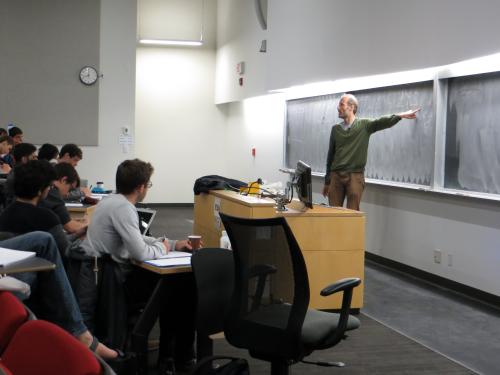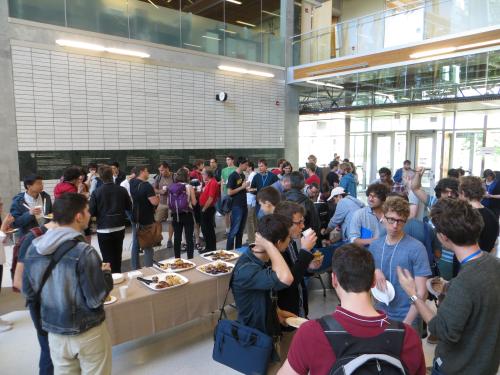Fields Medalist Martin Hairer Sits Down With PIMS
July 31st, 2017 will mark the very first time in PIMS’ 20 year history that we had three visiting Fields Medalists in three consecutive months. Steven Smale, winner of the Fields Medal in 1966, will be here as part of our Rufus Bowen event. In May, we had the pleasure of hosting Cédric Villani, a 2010 winner and recently elected Member of Parliament in France. And finally in June, as part of the 2017 PIMS & CRM Summer School in Probability (SSPROB), attendees from over 20 countries were treated to a mini course from Fields Medalist Martin Hairer.

Hairer was at UBC for a week of lectures culminating in a PIMS & UBC Department of Mathematics Distinguished Colloquium titled: On coin tosses, atoms, and forest fires. His talk was an engaging sample of the probabilistic lens, touching on some of the insights that have laid the foundation for his work.
Before the colloquium, PIMS had the pleasure of sitting down with Hairer to talk about his singular and extraordinary career; a career which includes numerous achievements such as a Philip Leverhulme Prize in 2008, a Fermat Prize in 2013, a Royal Society Fellowship in 2014, and the creation of a music-editing software platform which he began writing while still in high school.
Of course, it was his development of a new and groundbreaking mathematical theory that in 2014 won him the coveted Fields Medal. Known for bringing original thinking to the table, Hairer tried a novel approach that provided a solution for the problematic KPZ equation. This lauded approach became the groundwork for his Theory of Regularity Structures; a theory that, unlike its predecessors, could be applied in higher dimensions.
The Mathematical Physicist

Hairer’s path to mathematics began in the physics department at the University of Geneva. “In Geneva, the first year of math was basically a subset of the first year of physics,” he recounts. “I more or less did both math and physics at the same time. Even though technically my PhD was in the physics department, it was really a mathematical PhD.”
Despite originally focusing on theoretical physics, Hairer has since gone on to make profound advancements in stochastic dynamics and analysis. This stemmed from an interest in probability that developed more by chance than anything else. “Originally it was sort of a coincidence,” he laughs. “The thesis problem Jean-Pierre Eckmann, my advisor, gave me had a relatively strong probabilistic component. He had previously worked on that problem but not from a probability point of view. I started off working the way he was approaching these problems then I realized the probabilistic point of view was really quite powerful, and I liked that it was a bit more intuitive to work with.”
Hairer seems to be part of a new wave of mathematicians who have also come to see this intrinsic power in the probabilistic viewpoint. Up until 2006, there weren’t many probabilists winning Fields Medals. “You mean none,” says Hairer with a grin. And he’s right. Before 2006, one would be hard-pressed to find a probabilist amidst the roster of past winners. Since then, depending on how you count, there have been at least three. “Cédric Villani may not consider himself a probabilist, but what he does is not very far from probability,” jokes Hairer.
Why the sudden shift? Subject to how one reads mathematical history, probability wasn’t really around in the 1960s, and the general impression is that mainstream mathematics tended to view probability as something on the fringes. “They didn’t quite realize that it was a perfectly well-formulated theory. Probability theorems are no less than that of any other branch of mathematics. There’s really no difference,” says Hairer. “The other thing is that the work for which Wendelin Werner received the Fields Medal in 2006 instantly connected probability theory to many other branches of mathematics that pure mathematicians were much more aware of, or more interested in. People realized that it connected to a whole lot of interesting areas and it wasn’t just some specialized piece of mathematics with weird statements.”
Lecturing, Research, and Finding the Time

Since arriving at the forefront of probability theory, Hairer acknowledges that time has become increasingly difficult to come by. His summers are now spent attending events like the PIMS & CRM Summer School in Probability, which require international travel, networking, and lecturing. The calendar of a high-demand Fields Medalist leaves little time for pure research and hobbies like his HairerSoft platform, but he is still hard at work with his team of postdocs whenever he can squeeze in a moment. “We meet regularly, or as regularly as possible, as I’m often not there,” he says with laidback humour.
Flying across the globe and lecturing hundreds of burgeoning and veteran mathematicians does offer its own kind of opportunities to pursue the work, says Hairer. “It’s stimulating because you get to meet people you didn’t know before and you get to talk about the problems that they’re interested in. It helps for inspiration and getting into new pieces of math. Also, even more directly, taking a piece of your own work and trying to break it into bits that you can lecture on for an hour, two hours, three hours, it’s helpful for yourself, you sort of clarify your own thoughts.”

In regard to HairerSoft, he chuckles at the notion that he is an entrepreneur. There simply isn’t enough time for both entrepreneurialism and mathematics in his schedule. “I think I’m probably a bit of an outlier. There are instances of mathematicians who have left mathematics, Jim Simons is probably the most famous example of that, at least he’s the one who made the most money,” he laughs. “But I don’t know if I would recommend that in general though; if it interests you, then of course. I mean I wrote a big chunk of the codebase for that software when I was still a PhD student, there you can find time to do these sorts of things. But now, I don’t think I could find the time to do this from scratch.”
What Comes Next
There is a hint of homecoming to Hairer’s current and future research. The mathematical physicist is truly bridging the two disciplines as he brings probability to universality. In physics, the way a system behaves doesn’t depend all that much on the way it’s actually constructed at the microscopic level. As a very simplistic example, take water and alcohol. They are, molecularly, completely dissimilar, but at the macroscopic level, they are virtually indistinguishable both in appearance and behavior.
“This same sort of thing happens very often in probability theory,” Hairer explains. “You have something random that’s made up of lots of different random bits that all combine in order to give some kind of larger random outcome. Very often this outcome doesn’t really depend on how these little random bits are made up. Physicists have a very good intuition about that sort of thing, but mathematically, one still doesn’t have a good understanding of why this is the case.” His enthusiastic smile grows wider as he finishes, “that’s one of things I want to try to understand better.”
A Little Wisdom for Aspiring Mathematicians

Through and through, Hairer is a pure mathematician. When asked what he believes are the most promising areas of application for probability, he laughs and admits, “I’m not really interested in math for the sake of application. What interests me in mathematics is mathematics. If it allows you to better understand something in the real world, then that’s all the better, but I’m very happy to understand a piece of mathematics for itself.”
So what advice then, does a groundbreaking probabilist have for those graduate and undergraduate students aspiring toward a career in mathematics? “I think the general advice is to not so much try to figure out what’s the hot topic that you can go into and that will make you an instant star. It’s, I would think, more effective to redefine the area that genuinely interests you, because I think if you are sincerely interested in something, and you really like it, then you’re more likely to make good progress and contribute to that area.” He laughs out loud when he is told that this is truly great advice regardless of the field. “Yeah, that’s pretty much for anything, not just mathematics.”
It is an honour for PIMS to host mathematicians like Martin Hairer; leaders in their field who are inspiring examples to the students, faculty, and staff who take part in events and summer schools across all PIMS sites. We endeavor to bring awareness of the mathematical sciences to a broader, more diverse audience and Martin Hairer is an incredible spokesman for the true potential, and profound influence, of mathematics and probability in our world. As he himself says, “in many scientific disciplines, the deeper you look into certain things, very often, it ends up being problems either in probability or somehow with a probabilistic flavor.”
We hope that conversations like these will encourage the next generation of math students to see this same potential and look beyond the “hot topic” of the moment so that math’s reach will continue to exceed its grasp, and always strive beyond its perceived borders.
